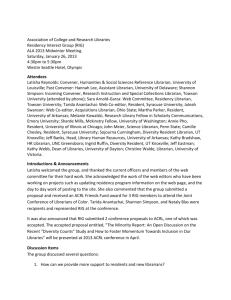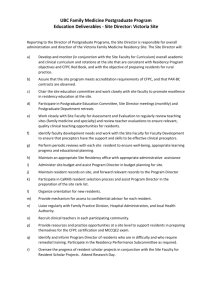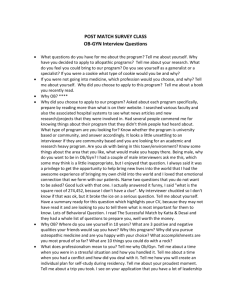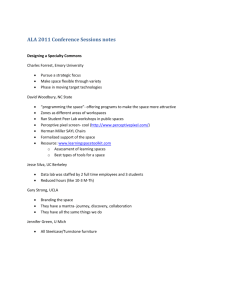2012 ALA Midwinter Meeting Minutes
advertisement
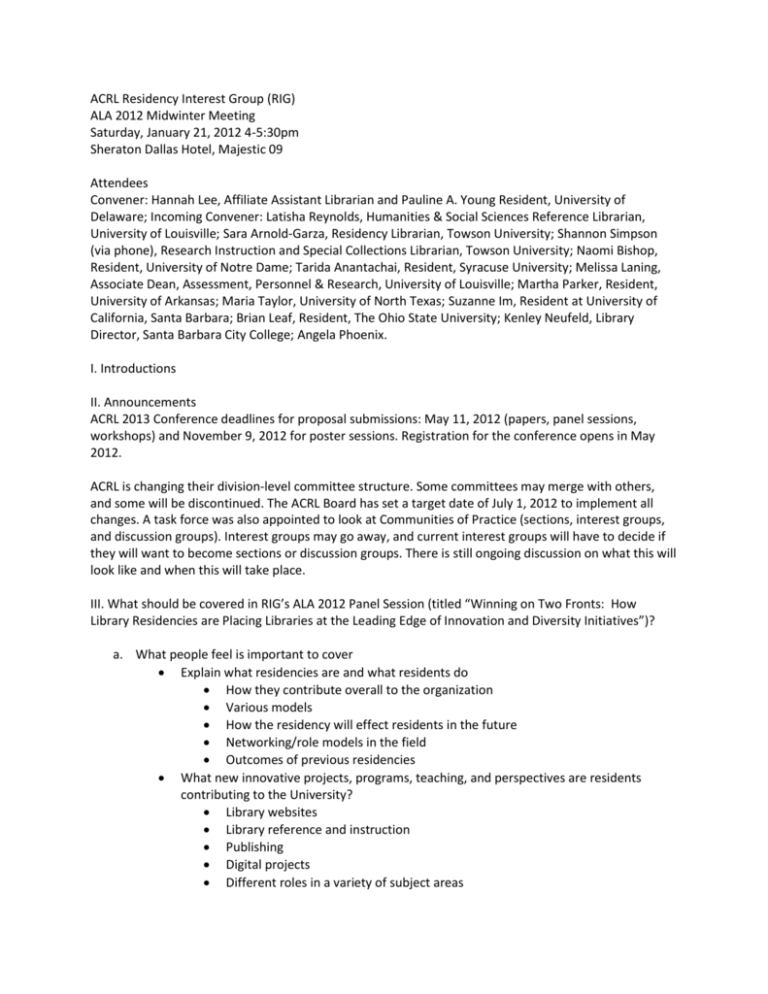
ACRL Residency Interest Group (RIG) ALA 2012 Midwinter Meeting Saturday, January 21, 2012 4-5:30pm Sheraton Dallas Hotel, Majestic 09 Attendees Convener: Hannah Lee, Affiliate Assistant Librarian and Pauline A. Young Resident, University of Delaware; Incoming Convener: Latisha Reynolds, Humanities & Social Sciences Reference Librarian, University of Louisville; Sara Arnold-Garza, Residency Librarian, Towson University; Shannon Simpson (via phone), Research Instruction and Special Collections Librarian, Towson University; Naomi Bishop, Resident, University of Notre Dame; Tarida Anantachai, Resident, Syracuse University; Melissa Laning, Associate Dean, Assessment, Personnel & Research, University of Louisville; Martha Parker, Resident, University of Arkansas; Maria Taylor, University of North Texas; Suzanne Im, Resident at University of California, Santa Barbara; Brian Leaf, Resident, The Ohio State University; Kenley Neufeld, Library Director, Santa Barbara City College; Angela Phoenix. I. Introductions II. Announcements ACRL 2013 Conference deadlines for proposal submissions: May 11, 2012 (papers, panel sessions, workshops) and November 9, 2012 for poster sessions. Registration for the conference opens in May 2012. ACRL is changing their division-level committee structure. Some committees may merge with others, and some will be discontinued. The ACRL Board has set a target date of July 1, 2012 to implement all changes. A task force was also appointed to look at Communities of Practice (sections, interest groups, and discussion groups). Interest groups may go away, and current interest groups will have to decide if they will want to become sections or discussion groups. There is still ongoing discussion on what this will look like and when this will take place. III. What should be covered in RIG’s ALA 2012 Panel Session (titled “Winning on Two Fronts: How Library Residencies are Placing Libraries at the Leading Edge of Innovation and Diversity Initiatives”)? a. What people feel is important to cover Explain what residencies are and what residents do How they contribute overall to the organization Various models How the residency will effect residents in the future Networking/role models in the field Outcomes of previous residencies What new innovative projects, programs, teaching, and perspectives are residents contributing to the University? Library websites Library reference and instruction Publishing Digital projects Different roles in a variety of subject areas Getting hired and being role models for future librarians of color Highlight the difficult moments of a residency New librarian professional Younger generation than the current workforce (seen as cute, energetic, and a student) New city or university No training or orientation to library (managing collections, e-resources, web) No clear job description or duties Chain of command (administration) Want to do new things, but sometimes not in an environment welcome to change Diversity (coming from a different background); not fitting into the community Don’t see the library making efforts and contributing to improve diverse collections and services Not getting “everything” duties and expectations in writing (having to switch areas) Not having a supportive resident coordinator Ignored by staff (staff and faculty support and knowledge of program) Time to write and research Time to serve and be a part of committees Building relationships (temporary 2 years) High expectations (want to supervise staff or students, want to gain experience in working with faculty) b. How and where should we promote this panel? Social media (Facebook/Twitter/ blogs/ web) Library school student chapters Traditional publications (ACRL News, ALA News, Cognotes) ALA Office for Diversity and Spectrum (Wendy and Miguel) Listservs (ARL, CRL, ACRL sections) David Free- ACRL Library administrators, mentors, ALA affiliate groups c. What sort of physical take away to provide to audience A bookmark with a link to the website and QR code Resources and contacts on Moo business cards Design of the program, recruiting, providing mentoring and orientation Professional development opportunities Resident network IV. Having the possibility of hosting a regular program during ALA for residents to present capstone projects? ACRL would be a better opportunity to present Formal review process and guidelines for projects? Call for proposals? Also discussed formats, ex. presentation, virtual or physical posters, etc. Collaborative projects among residents and institutions Focus projects on diversity issues, resources, higher education, community outreach Space on website to highlight projects Highlight former residents’ scholarship and leadership in academic libraries Grant opportunities V. Website Having a best practices page for coordinators on the RIG website that would provide info on the following: Clear written job descriptions and duties Developing a residency structure Design of program (two year rotations, two years in one area/department) Different types of residencies (subject areas, departments, teaching) Communicating with other coordinators Recruiting residents Mentoring Orientation Professional development Supervising How best to support the resident Getting faculty and staff buy-in Sharing written documents (Purdue University was mentioned as having written documentation that was helpful in the planning of certain residency programs) Connecting former and current residents Role models Support goals Celebrate success Networking--getting connected and finding a job Adding capstone projects to website 6. San Jose State IMLS grant project Ruth Metz spoke of the IMLS planning grant that San Jose State has received to plan and gather data for a residency model that would integrate emerging technologies They would match residents with host institutions The grant would provide for 5-10 residents and hosts They will be looking for host institutions possibly in 2014 They are in the process of gathering residents and coordinators’ input and feedback Diversity will not be a focus of the residencies o Attendees at the meeting talked about how diversity is important and should be a consideration The San Jose State planning team will come out with a white paper in February 2012 that will outline their residency model recommendations. The finished draft of the white paper may be posted on the RIG website. Minutes submitted by Naomi Bishop, Latisha Reynolds, and Hannah Lee

